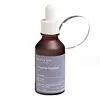What's inside
What's inside
 Key Ingredients
Key Ingredients

 Benefits
Benefits

 Concerns
Concerns

No concerns
 Ingredients Side-by-side
Ingredients Side-by-side

Water
Skin ConditioningGlycereth-26
Humectant1,2-Hexanediol
Skin ConditioningButylene Glycol
HumectantGlycerin
HumectantArginine
MaskingCarbomer
Emulsion StabilisingEthylhexylglycerin
Skin ConditioningPolyglyceryl-10 Laurate
Skin ConditioningAdenosine
Skin ConditioningCaprylyl Glycol
EmollientCopper Tripeptide-1
Skin ConditioningHexapeptide-11
Skin ConditioningHexapeptide-9
Skin ConditioningPalmitoyl Pentapeptide-4
Skin ConditioningPalmitoyl Tripeptide-1
Skin ConditioningTripeptide-1
Skin ConditioningWater
Skin ConditioningDipropylene Glycol
HumectantGlycerin
HumectantCaprylic/Capric Triglyceride
MaskingHydrogenated Poly(C6-14 Olefin)
EmollientHydrogenated Polydecene
EmollientPolyglyceryl-3 Methylglucose Distearate
EmulsifyingLimnanthes Alba Seed Oil
Skin ConditioningPentylene Glycol
Skin ConditioningCetearyl Alcohol
EmollientGlyceryl Stearate
EmollientHydrogenated Vegetable Oil
EmollientJojoba Esters
EmollientBehenyl Alcohol
Emollient1,2-Hexanediol
Skin ConditioningDipentaerythrityl Hexahydroxystearate/Hexastearate/Hexarosinate
Skin ConditioningPolymethylsilsesquioxane
Cetearyl Olivate
Sorbitan Olivate
EmulsifyingHydrogenated Lecithin
EmulsifyingMethyl Trimethicone
Skin ConditioningHydroxyacetophenone
AntioxidantHydroxyethyl Acrylate/Sodium Acryloyldimethyl Taurate Copolymer
Emulsion StabilisingBehenic Acid
CleansingCarbomer
Emulsion StabilisingTromethamine
BufferingStearic Acid
CleansingStearyl Alcohol
EmollientXanthan Gum
EmulsifyingAdenosine
Skin ConditioningCitrus Aurantium Bergamia Fruit Oil
MaskingPelargonium Graveolens Flower Oil
MaskingHydrolyzed Collagen
EmollientMelia Azadirachta Flower Extract
Skin ConditioningMyristic Acid
CleansingSodium Phytate
Melia Azadirachta Leaf Extract
Skin ConditioningCurcuma Longa Root Extract
MaskingOcimum Sanctum Leaf Extract
Skin ConditioningDextrin
AbsorbentTheobroma Cacao Seed Extract
AntioxidantCorallina Officinalis Extract
Skin ConditioningTocopherol
AntioxidantButylene Glycol
HumectantCaprylyl Glycol
EmollientEthylhexylglycerin
Skin ConditioningOligopeptide-1
Skin ConditioningAcetyl Hexapeptide-8
HumectantPalmitoyl Pentapeptide-4
Skin ConditioningWater, Dipropylene Glycol, Glycerin, Caprylic/Capric Triglyceride, Hydrogenated Poly(C6-14 Olefin), Hydrogenated Polydecene, Polyglyceryl-3 Methylglucose Distearate, Limnanthes Alba Seed Oil, Pentylene Glycol, Cetearyl Alcohol, Glyceryl Stearate, Hydrogenated Vegetable Oil, Jojoba Esters, Behenyl Alcohol, 1,2-Hexanediol, Dipentaerythrityl Hexahydroxystearate/Hexastearate/Hexarosinate, Polymethylsilsesquioxane, Cetearyl Olivate, Sorbitan Olivate, Hydrogenated Lecithin, Methyl Trimethicone, Hydroxyacetophenone, Hydroxyethyl Acrylate/Sodium Acryloyldimethyl Taurate Copolymer, Behenic Acid, Carbomer, Tromethamine, Stearic Acid, Stearyl Alcohol, Xanthan Gum, Adenosine, Citrus Aurantium Bergamia Fruit Oil, Pelargonium Graveolens Flower Oil, Hydrolyzed Collagen, Melia Azadirachta Flower Extract, Myristic Acid, Sodium Phytate, Melia Azadirachta Leaf Extract, Curcuma Longa Root Extract, Ocimum Sanctum Leaf Extract, Dextrin, Theobroma Cacao Seed Extract, Corallina Officinalis Extract, Tocopherol, Butylene Glycol, Caprylyl Glycol, Ethylhexylglycerin, Oligopeptide-1, Acetyl Hexapeptide-8, Palmitoyl Pentapeptide-4
 Reviews
Reviews

Ingredients Explained
These ingredients are found in both products.
Ingredients higher up in an ingredient list are typically present in a larger amount.
1,2-Hexanediol is a synthetic liquid and another multi-functional powerhouse.
It is a:
- Humectant, drawing moisture into the skin
- Emollient, helping to soften skin
- Solvent, dispersing and stabilizing formulas
- Preservative booster, enhancing the antimicrobial activity of other preservatives
Adenosine is in every living organism. It is one of four components in nucleic acids that helps store our DNA.
Adenosine has many benefits when used. These benefits include hydrating the skin, smoothing skin, and reducing wrinkles. Once applied, adenosine increases collagen production. It also helps with improving firmness and tissue repair.
Studies have found adenosine may also help with wound healing.
In skincare products, Adenosine is usually derived from yeast.
Learn more about AdenosineButylene Glycol (or BG) is used within cosmetic products for a few different reasons:
Overall, Butylene Glycol is a safe and well-rounded ingredient that works well with other ingredients.
Though this ingredient works well with most skin types, some people with sensitive skin may experience a reaction such as allergic rashes, closed comedones, or itchiness.
Learn more about Butylene GlycolCaprylyl Glycol is a humectant and emollient, meaning it attracts and preserves moisture.
It is a common ingredient in many products, especially those designed to hydrate skin. The primary benefits are retaining moisture, skin softening, and promoting a healthy skin barrier.
Though Caprylyl Glycol is an alcohol derived from fatty acids, it is not the kind that can dry out skin.
This ingredient is also used as a preservative to extend the life of products. It has slight antimicrobial properties.
Learn more about Caprylyl GlycolCarbomer is a polymer of acrylic acid. Its main role is to create a gel consistency.
A high amount of carbomer can cause pilling or balling up of products. Don't worry, most products contain 1% or less of carbomer.
Ethylhexylglycerin (we can't pronounce this either) is commonly used as a preservative and skin softener. It is derived from glyceryl.
You might see Ethylhexylglycerin often paired with other preservatives such as phenoxyethanol. Ethylhexylglycerin has been found to increase the effectiveness of these other preservatives.
Glycerin is already naturally found in your skin. It helps moisturize and protect your skin.
A study from 2016 found glycerin to be more effective as a humectant than AHAs and hyaluronic acid.
As a humectant, it helps the skin stay hydrated by pulling moisture to your skin. The low molecular weight of glycerin allows it to pull moisture into the deeper layers of your skin.
Hydrated skin improves your skin barrier; Your skin barrier helps protect against irritants and bacteria.
Glycerin has also been found to have antimicrobial and antiviral properties. Due to these properties, glycerin is often used in wound and burn treatments.
In cosmetics, glycerin is usually derived from plants such as soybean or palm. However, it can also be sourced from animals, such as tallow or animal fat.
This ingredient is organic, colorless, odorless, and non-toxic.
Glycerin is the name for this ingredient in American English. British English uses Glycerol/Glycerine.
Learn more about GlycerinYou might know this ingredients as Matrixyl, a famous peptide.
Peptides are building blocks for protein. Palmitoyl Pentapeptide-4 consists of five amino acids. These amino acids include: 2 lysines, 2 threonines, and serine
This ingredients tells our body to create more collagen. Collagen is a protein that makes connective tissue. Boosting collagen production leads to a healthier skin barrier. Having a healthy skin barrier means having firm and hydrated skin.
Thus, Matrixyl may help improve the look of wrinkles.
Read more about other common types of peptides here:
Learn more about Palmitoyl Pentapeptide-4Water. It's the most common cosmetic ingredient of all. You'll usually see it at the top of ingredient lists, meaning that it makes up the largest part of the product.
So why is it so popular? Water most often acts as a solvent - this means that it helps dissolve other ingredients into the formulation.
You'll also recognize water as that liquid we all need to stay alive. If you see this, drink a glass of water. Stay hydrated!
Learn more about Water